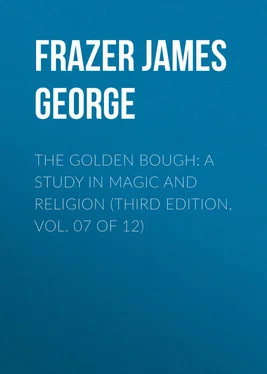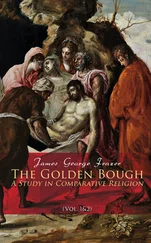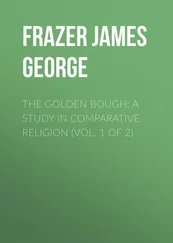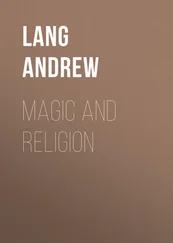James Frazer - The Golden Bough - A Study in Magic and Religion (Third Edition, Vol. 07 of 12)
Здесь есть возможность читать онлайн «James Frazer - The Golden Bough - A Study in Magic and Religion (Third Edition, Vol. 07 of 12)» — ознакомительный отрывок электронной книги совершенно бесплатно, а после прочтения отрывка купить полную версию. В некоторых случаях можно слушать аудио, скачать через торрент в формате fb2 и присутствует краткое содержание. Жанр: foreign_religion, foreign_antique, foreign_prose, на английском языке. Описание произведения, (предисловие) а так же отзывы посетителей доступны на портале библиотеки ЛибКат.
- Название:The Golden Bough: A Study in Magic and Religion (Third Edition, Vol. 07 of 12)
- Автор:
- Жанр:
- Год:неизвестен
- ISBN:нет данных
- Рейтинг книги:5 / 5. Голосов: 1
-
Избранное:Добавить в избранное
- Отзывы:
-
Ваша оценка:
- 100
- 1
- 2
- 3
- 4
- 5
The Golden Bough: A Study in Magic and Religion (Third Edition, Vol. 07 of 12): краткое содержание, описание и аннотация
Предлагаем к чтению аннотацию, описание, краткое содержание или предисловие (зависит от того, что написал сам автор книги «The Golden Bough: A Study in Magic and Religion (Third Edition, Vol. 07 of 12)»). Если вы не нашли необходимую информацию о книге — напишите в комментариях, мы постараемся отыскать её.
The Golden Bough: A Study in Magic and Religion (Third Edition, Vol. 07 of 12) — читать онлайн ознакомительный отрывок
Ниже представлен текст книги, разбитый по страницам. Система сохранения места последней прочитанной страницы, позволяет с удобством читать онлайн бесплатно книгу «The Golden Bough: A Study in Magic and Religion (Third Edition, Vol. 07 of 12)», без необходимости каждый раз заново искать на чём Вы остановились. Поставьте закладку, и сможете в любой момент перейти на страницу, на которой закончили чтение.
Интервал:
Закладка:
Dionysus as a god of agriculture and the corn. The winnowing-fan as an emblem of Dionysus.
Further, there are indications, few but significant, that Dionysus was conceived as a deity of agriculture and the corn. He is spoken of as himself doing the work of a husbandman: 22 22 Himerius, Orat. i. 10, Δίονυσος γεωργεῖ.
he is reported to have been the first to yoke oxen to the plough, which before had been dragged by hand alone; and some people found in this tradition the clue to the bovine shape in which, as we shall see, the god was often supposed to present himself to his worshippers. Thus guiding the ploughshare and scattering the seed as he went, Dionysus is said to have eased the labour of the husbandman. 23 23 Diodorus Siculus, iii. 64. 1-3, iv. 4. 1 sq. On the agricultural aspect of Dionysus, see L. R. Farnell, The Cults of the Greek States , v. (Oxford, 1909) pp. 123 sq.
Further, we are told that in the land of the Bisaltae, a Thracian tribe, there was a great and fair sanctuary of Dionysus, where at his festival a bright light shone forth at night as a token of an abundant harvest vouchsafed by the deity; but if the crops were to fail that year, the mystic light was not seen, darkness brooded over the sanctuary as at other times. 24 24 [Aristotle,] Mirab. Auscult. 122 (p. 842 a, ed. Im. Bekker, Berlin edition).
Moreover, among the emblems of Dionysus was the winnowing-fan, that is the large open shovel-shaped basket, which down to modern times has been used by farmers to separate the grain from the chaff by tossing the corn in the air. This simple agricultural instrument figured in the mystic rites of Dionysus; indeed the god is traditionally said to have been placed at birth in a winnowing-fan as in a cradle: in art he is represented as an infant so cradled; and from these traditions and representations he derived the epithet of Liknites , that is, “He of the Winnowing-fan.” 25 25 Servius on Virgil, Georg. i. 166; Plutarch, Isis et Osiris , 35. The literary and monumental evidence as to the winnowing-fan in the myth and ritual of Dionysus has been collected and admirably interpreted by Miss J. E. Harrison in her article “Mystica Vannus Iacchi,” Journal of Hellenic Studies , xxiii. (1903) pp. 292-324. Compare her Prolegomena to the Study of Greek Religion 2 (Cambridge, 1908), pp. 517 sqq. I must refer the reader to these works for full details on the subject. In the passage of Servius referred to the reading is somewhat uncertain; in his critical edition G. Thilo reads λικμητὴν and λικμὸς instead of the usual λικνιτὴν and λικνόν. But the variation does not affect the meaning.
Use of the winnowing-fan to cradle infants. The winnowing-fan sometimes intended to avert evil spirits from children.
At first sight this symbolism might be explained very simply and naturally by supposing that the divine infant cradled in the winnowing-fan was identified with the corn which it is the function of the instrument to winnow and sift. Yet against this identification it may be urged with reason that the use of a winnowing-fan as a cradle was not peculiar to Dionysus; it was a regular practice with the ancient Greeks to place their infants in winnowing-fans as an omen of wealth and fertility for the future life of the children. 26 26 Ἐν γὰρ λείκνοις τὸ παλαιὸν κατεκοίμιζον τὰ Βρέφη πλοῦτον καὶ καρπούς οἰωνιζόμενοι, Scholiast on Callimachus, i. 48 ( Callimachea , edidit O. Schneider, Leipsic, 1870-1873, vol. i. p. 109).
Customs of the same sort have been observed, apparently for similar reasons, by other peoples in other lands. For example, in Java it is or used to be customary to place every child at birth in a bamboo basket like the sieve or winnowing-basket which Javanese farmers use for separating the rice from the chaff. 27 27 T. S. Raffles, History of Java (London, 1817), i. 323; C. F. Winter, “Instellingen, Gewoontenen Gebruiken der Javanen te Soerakarta,” Tijdschrift voor Neêrlands Indie , Vijfde Jaargang, Eerste Deel (1843), p. 695; P. J. Veth, Java (Haarlem, 1875-1884), i. 639.
It is the midwife who places the child in the basket, and as she does so she suddenly knocks with the palms of both hands on the basket in order that the child may not be timid and fearful. Then she addresses the child thus: “Cry not, for Njaï-among and Kaki-among” (two spirits) “are watching over you.” Next she addresses these two spirits, saying, “Bring not your grandchild to the road, lest he be trampled by a horse; bring him not to the bank of the river, lest he fall into the river.” The object of the ceremony is said to be that these two spirits should always and everywhere guard the child. 28 28 C. Poensen, “Iets over de kleeding der Javanen,” Mededeelingen van wege het Nederlandsche Zendelinggenootschap , xx. (1876) pp. 279 sq.
On the first anniversary of a child's birthday the Chinese of Foo-Chow set the little one in a large bamboo sieve, such as farmers employ in winnowing grain, and in the sieve they place along with the child a variety of articles, such as fruits, gold or silver ornaments, a set of money-scales, books, a pencil, pen, ink, paper, and so on, and they draw omens of the child's future career from the object which it first handles and plays with. Thus, if the infant first grasps the money-scale, he will be wealthy; if he seizes on a book, he will be learned, and so forth. 29 29 Rev. J. Doolittle, Social Life of the Chinese , edited and revised by the Rev. Paxton Hood (London, 1868), pp. 90 sq.
In the Bilaspore district of India it is customary for well-to-do people to place a newborn infant in a winnowing-fan filled with rice and afterwards to give the grain to the nurse in attendance. 30 30 Rev. E. M. Gordon, “Some Notes concerning the People of Mungēli Tahsīl, Bilaspur District,” Journal of the Asiatic Society of Bengal , lxxi., Part iii. (Calcutta, 1903) p. 74; id. , Indian Folk Tales (London, 1908), p. 41.
In Upper Egypt a newly-born babe is immediately laid upon a corn-sieve and corn is scattered around it; moreover, on the seventh day after birth the infant is carried on a sieve through the whole house, while the midwife scatters wheat, barley, pease and salt. The intention of these ceremonies is said to be to avert evil spirits from the child, 31 31 C. B. Klunzinger, Bilder aus Oberägypten (Stuttgart, 1877), pp. 181, 182; id. , Upper Egypt, its People and Products (London, 1878), pp. 185, 186.
and a like motive is assigned by other peoples for the practice of placing newborn infants in a winnowing-basket or corn-sieve. For example, in the Punjaub, when several children of a family have died in succession, a new baby will sometimes be put at birth into an old winnowing-basket ( chhaj ) along with the sweepings of the house, and so dragged out into the yard; such a child may, like Dionysus, in after life be known by the name of Winnowing-basket ( Chhajju ) or Dragged ( Ghasitâ ). 32 32 R. C. Temple, “Opprobrious Names,” Indian Antiquary , x. (1881) pp. 331 sq. Compare H. A. Rose, “Hindu Birth Observances in the Punjab,” Journal of the Royal Anthropological Institute , xxxvii. (1907) p. 234. See also Panjab Notes and Queries , vol. iii. August 1886, § 768, pp. 184 sq. : “The winnowing fan in which a newly-born child is laid, is used on the fifth day for the worship of Satwáí. This makes it impure, and it is henceforward used only for the house-sweepings.”
The object of treating the child in this way seems to be to save its life by deceiving the spirits, who are supposed to have carried off its elder brothers and sisters; these malevolent beings are on the look-out for the new baby, but they will never think of raking for it in the dust-bin, that being the last place where they would expect to find the hope of the family. The same may perhaps be the intention of a ceremony observed by the Gaolis of the Deccan. As soon as a child is born, it is bathed and then placed on a sieve for a few minutes. On the fifth day the sieve, with a lime and pan leaves on it, is removed outside the house and then, after the worship of Chetti has been performed, the sieve is thrown away on the road. 33 33 Lieut. – Colonel Gunthorpe, “On the Ghosí or Gaddí Gaolís of the Deccan,” Journal of the Anthropological Society of Bombay , i. 45.
Again, the same notion of rescuing the child from dangerous spirits comes out very clearly in a similar custom observed by the natives of Laos, a province of Siam. These people “believe that an infant is the child, not of its parents, but of the spirits, and in this belief they go through the following formalities. As soon as an infant is born it is bathed and dressed, laid upon a rice-sieve, and placed – by the grandmother if present, if not, by the next near female relative – at the head of the stairs or of the ladder leading to the house. The person performing this duty calls out in a loud tone to the spirits to come and take the child away to-day, or for ever after to let it alone; at the same moment she stamps violently on the floor to frighten the child, or give it a jerk, and make it cry. If it does not cry this is regarded as an evil omen. If, on the other hand, it follows the ordinary laws of nature and begins to exercise its vocal organs, it is supposed to have a happy and prosperous life before it. Sometimes the spirits do come and take the infant away, i. e. it dies before it is twenty-four hours old, but, to prevent such a calamity, strings are tied round its wrists on the first night after its birth, and if it sickens or is feeble the spirit-doctors are called in to prescribe certain offerings to be made to keep away the very spirits who, only a few hours previously, were ceremoniously called upon to come and carry the child off. On the day after its birth the child is regarded as being the property no longer of the spirits, who could have taken it if they had wanted it, but of the parents, who forthwith sell it to some relation for a nominal sum – an eighth or a quarter of a rupee perhaps. This again is a further guarantee against molestation by the spirits, who apparently are regarded as honest folk that would not stoop to take what has been bought and paid for.” 34 34 C. Bock, Temples and Elephants (London, 1884), pp. 258 sq.
Интервал:
Закладка:
Похожие книги на «The Golden Bough: A Study in Magic and Religion (Third Edition, Vol. 07 of 12)»
Представляем Вашему вниманию похожие книги на «The Golden Bough: A Study in Magic and Religion (Third Edition, Vol. 07 of 12)» списком для выбора. Мы отобрали схожую по названию и смыслу литературу в надежде предоставить читателям больше вариантов отыскать новые, интересные, ещё непрочитанные произведения.
Обсуждение, отзывы о книге «The Golden Bough: A Study in Magic and Religion (Third Edition, Vol. 07 of 12)» и просто собственные мнения читателей. Оставьте ваши комментарии, напишите, что Вы думаете о произведении, его смысле или главных героях. Укажите что конкретно понравилось, а что нет, и почему Вы так считаете.












